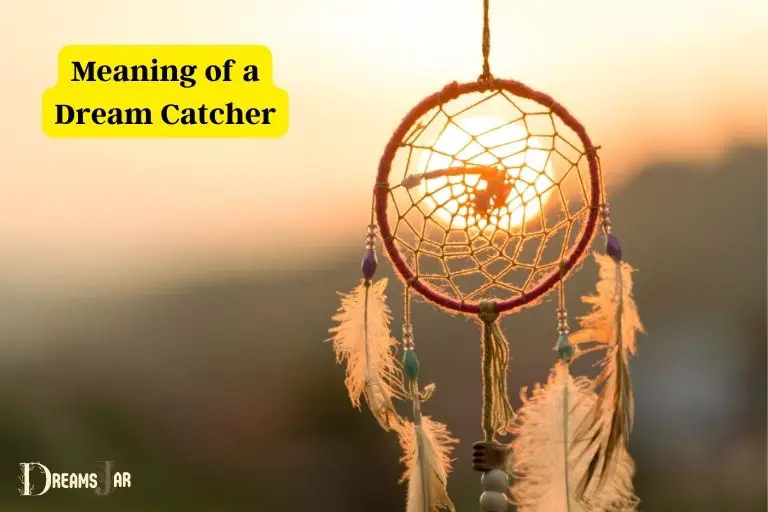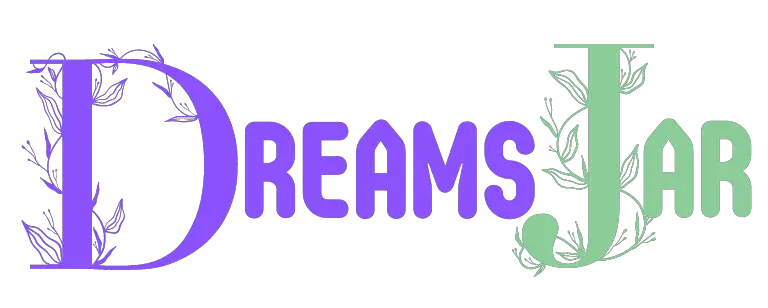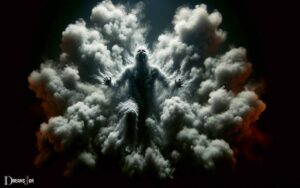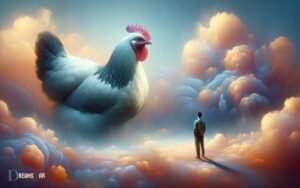What Is the Meaning of a Dream Catcher? Protection!
A dream catcher is a Native American talisman meant to safeguard individuals from negative dreams and energies while promoting pleasant dreams.
The Dream Catcher works on the belief that the night air is filled with dreams, both good and bad. The dream catcher’s intricate web design traps the bad dreams, allowing them to disappear with the first light of dawn.
On the other hand, good dreams are believed to pass through the center hole and slide down the feathers to reach the sleeping person below, providing them with pleasant dreams and positive energy.
Dream catchers have a rich history, originating from the Ojibwe tribe, where they were revered for spiritual protection.
Designed with a circular frame, a woven web, and adorned with feathers, beads, and personal tokens, these beautiful creations serve as a mystical guardian, chasing away bad dreams and capturing the positive ones for those who sleep beneath them.
8 Components: Meaning of a Dream Catcher
| Component | Description |
|---|---|
| Hoop | Represents the circle of life and the shape of the Earth, Sun, and Moon. It’s a symbol of unity and wholeness. |
| Web | Mimics a spider’s web, which is believed to catch bad dreams and filter them out. The web also signifies the connection to all living beings on the planet. |
| Feathers | Attached to the bottom of the dream catcher, feathers are used to help guide good dreams to the person sleeping below. They also symbolize air, breath, and the spirit. |
| Beads | Often used for decoration, beads can also represent the spider that created the web or the good dreams that have been caught. |
| Gemstones | Some dream catchers include gemstones or crystals, which are believed to hold different energies and healing properties. |
| Colors | The colors used in constructing a dream catcher can have various meanings, often relating to the person who creates or receives it. For example, red may signify strong emotions, while blue represents calmness and healing. |
| Size & Shape | Dream catchers come in various sizes and shapes, with the most common being a circular hoop. Smaller ones are believed to catch more specific types of dreams, while larger ones are said to offer broader protection. |
| Origin | The dream catcher originated from the Ojibwe people, who believed that the “Spider Woman” created webs to protect their people from bad dreams. Over time, the tradition spread to other Native American tribes and eventually, to the wider world. |
Key Takeaway

Five Facts About: Dream Catchers
What Is A Dream Catcher?
Dream catchers have become a popular decorative item, often seen hanging in windows, above beds, or in cars. But what is the meaning behind these intricate creations?
We will explore the origin and cultural significance of dream catchers, as well as their symbolism and meaning.
Origin And Cultural Significance
- Dream catchers originated from native american culture, specifically the ojibwe people. They believed that dream catchers had the power to catch and filter out bad dreams.
- The ojibwe word for dream catcher is “asabikeshiinh” which means “spider,” as dream catchers are traditionally woven in the shape of a spider web.
- According to the ojibwe legend, asibikaashi, the spider woman, helped protect her people by weaving a web to catch the bad dreams, while allowing good dreams to pass through.
Symbolism And Meaning
- Dream catchers symbolize protection and guidance. They are believed to ward off negative energy and protect the sleeper from bad dreams.
- The hoop of the dream catcher represents the circle of life or the circle of the sun, while the web represents the interconnection of all living things.
- The feathers hanging from the bottom of the dream catcher are said to help guide the good dreams down to the sleeper.
Exploring the history of dream catchers reveals their cultural significance and the belief in their power to protect against bad dreams.
The symbolism behind dream catchers highlights their connection to the natural world and their role in guiding positive energy.
Whether you choose to hang a dream catcher as a decorative piece or embrace its deeper meaning, these fascinating creations continue to captivate people around the world.
How Does A Dream Catcher Work?
The Structure And Design
Dream catchers are intricate and beautiful objects that are believed to have originated from native american cultures. Although the designs and materials used may vary, the basic structure of a dream catcher remains the same.
Here are the key points to understand about the structure and design of a dream catcher:
- The dream catcher consists of a round hoop made from flexible materials such as willow or grapevine. This hoop represents the web of life and symbolizes unity and harmony.
- The hoop is then woven with a web-like pattern using natural fibers like sinew or thread. This intricate weaving creates a pattern that resembles a spider’s web, with a hole left in the center.
- The web is often embellished with beads, feathers, and other decorative elements, which are believed to enhance its spiritual power and protective properties.
- Hanging from the bottom of the hoop are various strands, usually made from feathers or other natural materials. These strands are meant to move freely and capture any negative energy or bad dreams that may enter the dream catcher.
- The design of the dream catcher is not only visually appealing but also holds deep symbolism and cultural significance.
The Purpose Of The Web And The Hoop
The web and the hoop of a dream catcher serve distinct purposes and play important roles in its functionality.
Here’s what you need to know about the purpose of these two elements:
- The web, woven within the hoop, acts as a filter for dreams. It is believed to catch dreams that float in the air during the night. The intricate pattern of the web works as a net to trap bad dreams and negative thoughts, preventing them from reaching the dreamer.
- Good dreams, on the other hand, are said to glide down the strands and gently enter the mind of the dreamer through the center hole of the web. These dreams are considered positive and full of wisdom and guidance.
- The hoop, which serves as the framework for the web, represents the circle of life and the eternal cycle of energy. It is believed to mimic the shape of the sun, moon, and earth, symbolizing the interconnectedness of all beings.
- Together, the web and the hoop of a dream catcher work harmoniously to create a protective shield that filters out negative energy and allows positive energy to flow freely.
Understanding The Elements Of A Dream Catcher
To fully grasp the meaning and purpose behind a dream catcher, it is essential to understand the significance of its individual elements.
Here’s a breakdown of the elements typically incorporated into a dream catcher:
- Hoop: Represents the circle of life, unity, and harmony.
- Web: Acts as a filter for dreams, catching negative energy and allowing positive energy to pass through.
- Center hole: Serves as an entry point for good dreams, wisdom, and guidance.
- Beads: Symbolize the interconnectedness of all things and can provide additional protection.
- Feathers: Represent the breath of life and are believed to carry dreams.
By comprehending the symbolism behind each element, one can appreciate the deeper meaning and significance of a dream catcher.
It is not just a decorative item but a spiritual tool believed to bring protection and positive energy into the lives of those who possess it.
Remember, dream catchers have different variations and interpretations across cultures. However, the core principles of filtering dreams and symbolizing unity and protection remain consistent.
Interpreting Dream Catcher Symbolism
Dream catchers are mystical and intriguing objects that have captivated people’s fascination for centuries. These beautiful and intricate creations hold deep symbolism and are often associated with native american cultures.
The dream catcher is believed to possess the power to filter out negative dreams and allow only positive and meaningful ones to pass through.
The Feathers: Significance And Representation
Feathers are an essential component of a dream catcher and hold special meaning in native american culture.
Here are the key points regarding the significance and representation of feathers:
- Feathers symbolize wisdom, purity, and spirituality.
- They are considered as a bridge between the earthly and spiritual realms.
- Feathers also represent communication with the divine and the ability to receive guidance through dreams.
- Different types of feathers, such as owl feathers or eagle feathers, might have specific associations and meanings.
The Web: Capturing And Filtering Dreams
The central aspect of a dream catcher is the intricate web woven within its circular frame.
Here are the essential details about the web and its role in capturing and filtering dreams:
- The web is believed to act as a filter, capturing dreams as they float in the air during the night.
- The intricate pattern of the web is thought to trap negative dreams and thoughts, preventing them from entering the dreamer’s mind.
- Meanwhile, positive and meaningful dreams are believed to pass through the holes of the web and gently slide down to the sleeper.
- The web’s design mimics that of a spider’s web, symbolizing the interconnectedness of all life and the spiritual journey.
Beads And Other Decorative Elements
Dream catchers are often adorned with beads, gemstones, shells, and other decorative elements. These embellishments add beauty and significance to the overall symbolism.
Here’s what you need to know:
- Beads are commonly used in dream catchers and represent the interconnectedness of dreams and reality.
- Gemstones, such as amethyst or turquoise, are believed to enhance spiritual connections and promote healing and protection.
- Shells incorporated into dream catchers reflect the importance of water in native american traditions and signify the presence of positive energy and good fortune.
- Other decorative elements, such as charms or feathers hanging below the dream catcher, can enhance personal symbolism or hold individual significance.
Dream catchers carry a rich symbolic language infused with spirituality and cultural heritage. Understanding their various elements empowers us to interpret the deep meaning behind their design.
Whether you have a dream catcher adorning your space or simply appreciate their beauty, these intricate creations continue to captivate our imagination and provide a connection to the mystical realm of dreaming.
The Role Of Dream Catchers In Native American Culture
Dream catchers have become popular decorative items that are often seen hanging in homes, offices, and even cars. But what is the meaning behind these intricate handmade creations?
Dream catchers have a rich history and hold deep significance in native american culture.
Rituals And Ceremonies Involving Dream Catchers
- Dream catchers are traditionally used by native american tribes, such as the ojibwe and lakota, to protect individuals from bad dreams and nightmares.
- They are often hung near the bed or in the home to catch bad dreams in their intricate webbing, allowing only good dreams to pass through.
- Dream catchers are believed to have the power to filter and purify dreams, ensuring that only positive and meaningful dreams reach the dreamer.
- In some native american ceremonies, dream catchers are used as a tool to connect with spiritual guides and ancestors during prayer and meditation.
- The process of making a dream catcher is also considered a sacred practice, with each component carrying its own symbolic meaning.
The Impact Of Colonization And Commercialization
- The history of dream catchers is intertwined with the effects of colonization and commercialization on native american culture.
- With the colonization of north america, traditional native american practices, including the use of dream catchers, were suppressed and discouraged.
- However, in recent years, dream catchers have gained popularity as decorative items, often produced and sold on a mass scale without proper regard for their cultural significance.
- This commercialization has led to a dilution of the original spiritual and cultural meaning behind dream catchers, reducing them to mere fashionable accessories for non-native individuals.
- It is important to recognize and respect the origin and significance of dream catchers, understanding that they are more than just trendy decorations.
Dream Catchers As A Form Of Cultural Appropriation
- Cultural appropriation occurs when elements of one culture are adopted by another culture without proper understanding, respect, or acknowledgement.
- The widespread commercialization and misrepresentation of dream catchers can be seen as a form of cultural appropriation.
- Misappropriation of native american symbols, such as dream catchers, can perpetuate stereotypes and trivialize the richness and complexity of native american culture.
- Non-native individuals purchasing and displaying dream catchers without understanding their significance can be seen as disrespectful and insensitive.
- It is essential to approach dream catchers and other cultural artifacts with humility, curiosity, and respect, honoring their native american roots.
Dream catchers have a deep and meaningful history within native american culture, serving as more than just decorative items.
Understanding their significance and respecting their origins is crucial to appreciating and honoring the traditions and wisdom of native american communities.
Choosing And Using Dream Catchers
Dream catchers are not just beautiful ornaments; they also hold spiritual significance for many cultures. If you’re considering getting a dream catcher or already have one, it’s important to know how to choose the right one and use it effectively.
We will explore what to consider when selecting a dream catcher, placement and positioning for maximum effectiveness, and caring for and maintaining your dream catcher. Let’s delve into the world of dream catchers and unlock their true potential.
What To Consider When Selecting A Dream Catcher
When it comes to choosing a dream catcher, there are a few key factors to keep in mind.
Here are some points to consider:
- Size: Dream catchers come in various sizes, so choose one that suits your preference and the space where you plan to display it.
- Design: Dream catchers are available in a wide range of designs, from traditional to modern. Select a design that resonates with you and reflects your personal style.
- Materials: Dream catchers can be made from different materials such as feathers, beads, and strings. Consider the materials used and opt for ones that align with your values and preferences.
- Authenticity: If you value authenticity, ensure that the dream catcher you choose is handcrafted by artisans who have the cultural background and expertise in creating these sacred objects.
Placement And Positioning For Maximum Effectiveness
To make the most of your dream catcher, it’s essential to place and position it correctly.
Here are some tips to maximize its effectiveness:
- Hang it above your bed: Traditionally, dream catchers are hung above the bed, where they can capture and filter dreams while you sleep. Make sure it’s within your line of sight when lying down.
- Face the opening towards you: When hanging the dream catcher, ensure that the open center or the “web” is facing the direction where you sleep. This allows it to catch negative energy and let positive energy flow through.
- Avoid direct sunlight: Dream catchers are delicate and can fade or deteriorate when exposed to direct sunlight for extended periods. Place it in an area where it’s protected from harsh sunlight.
Caring For And Maintaining A Dream Catcher
To ensure your dream catcher remains in excellent condition and retains its energy over time, follow these care and maintenance tips:
- Regular dusting: Gently dust your dream catcher with a soft cloth or feather duster on a regular basis to keep it clean and free from any buildup.
- Smudging: Use the smoke from sacred herbs such as sage or palo santo to cleanse and purify the dream catcher. Light the herb and let the smoke waft over the dream catcher to remove any negative energy.
- Avoid touching the web: The web of the dream catcher is delicate, so it’s best to avoid touching it excessively. Handle the dream catcher by its frame or hanging loop instead.
- Repair if needed: Over time, dream catchers may require some repair, especially if feathers or strands become loose or damaged. Use thread and glue to mend any broken parts or seek professional assistance if necessary.
Now that you know what to consider when selecting a dream catcher, how to position it for maximum effectiveness, and how to care for and maintain it, you can make the most of this beautiful and meaningful object.
Embrace the power of dream catchers and let them usher in positive energy and protect your dreams.
FAQ About the Meaning of a Dream Catcher
What is a dream catcher?
A dream catcher is a handcrafted Native American object believed to protect the individual sleeping under it from bad dreams and nightmares, while letting good dreams pass through the web and drift down the feathers to the sleeper.
What are the traditional components of a dream catcher?
Traditional components of a dream catcher include a bent hoop of willow or sinew, which is woven with webbing of sinew strands and decorated with feathers, beads, and other materials.
Where did the dream catcher originate from?
The dream catcher originated from Native American folklore and traditionally take the form of a hoop decorated with a web of sinew strands, feathers and beads.
What is the spiritual meaning of a dream catcher?
The spiritual meaning behind the dream catcher is that the web filters out all of the bad dreams, leaving only the good dreams to pass through the center hole and drift down the feathers. The dream catcher is believed to be a symbol of protection.
Conclusion
A dream catcher is much more than just a beautiful decoration for your home. It is rooted in native american culture and holds deep spiritual meaning.
By hanging a dream catcher above your bed, you are embracing the belief that it has the power to ward off bad dreams and negative energy, allowing only positive dreams to filter through.
Not only does it serve as a symbol of protection and harmony, but it also reminds us of the importance of our dreams and the potential they hold.
Whether you choose to follow the traditional legends or simply appreciate the intricate craftsmanship, a dream catcher is a meaningful and captivating addition to any space.
So next time you gaze at the delicate webbing and feathers, take a moment to reflect on its rich history and the profound impact it can have on your well-being.
Bonus Topic For-the Meaning of a Dream Catcher
What Is a Dream Catcher?
A dream catcher is a traditional Native American object, believed to protect people from bad dreams and negative energy.
It typically consists of a hoop, a web-like pattern, and various embellishments such as feathers, beads, or crystals.
- Origin: Native American cultures, particularly the Ojibwe and Lakota nations
- Purpose: To filter out bad dreams and allow only positive thoughts to reach the sleeper
- Design: Hoop, web-like pattern, feathers, beads or crystals
- Symbolism: The circular shape represents the circle of life, while the web catches and filters dreams
How Was the Dream Catcher Invented?
The dream catcher was invented by the Ojibwe people, Native Americans who originated from the northeastern part of North America.
It was created as a spiritual tool to protect individuals from nightmares and ensure pleasant dreams.
The meaning of the dream catcher lies in its unique design, which is believed to possess the power to filter dreams and capture negative energy.
- Symbolizes protection and good dreams
- Originated from Ojibwe people
- Represents the spider web
- Spiritual tool to ensure peaceful sleep
What Are the Different Meanings Associated With Dream Catchers?
Dream catchers are mystical objects believed to protect sleepers from nightmares and bad dreams.
They have different meanings associated with their origin, design, and symbolism. Here are some key meanings associated with dream catchers:
- Protection against nightmares: Dream catchers are known for their ability to purportedly trap bad dreams and negative energy, allowing only positive dreams to pass through.
- Native American tradition: Dream catchers were initially created by the Ojibwe (Chippewa) tribe, and their significance and symbolism can be traced back to their cultural roots and beliefs.
- Connection to nature: Natural materials such as feathers, beads, and gemstones are often incorporated in dream catcher designs, symbolizing a harmonious relationship with nature and its elements.
- Spiritual guidance: Many believe that dream catchers also serve as spiritual guides, providing wisdom and insight into the dreamer’s life path and personal growth.
- Artistic expression: Each dream catcher is unique, showcasing the creativity and individuality of the artist, reflecting the dreamer’s personality and aspirations.
In summary, dream catchers represent a rich blend of cultural heritage, spirituality, protection, and personal expression, making them fascinating objects with layered meanings.
What Is the Symbolism of Dream Catchers and How Can They Be Used?
Dream catchers are symbolic items with rich roots in Native American culture. They were traditionally used to protect individuals from negative energies, specifically nightmares.
The purpose of a dream catcher is to filter dreams, allowing only positive ones to pass through to the dreamer, while trapping the negative dreams in the intricate webbing.
- Origin: Native American culture
- Purpose: Protect from nightmares and negative energies
- Symbolism: Filtering dreams, and allowing only positivity
Dream catchers can be used in various ways, such as:
- Hanging as a decorative piece: Place them above your bed, near windows, or in living spaces.
- Gifting to loved ones: Share the protection and positive energy with friends and family.
- Personalizing for specific intentions: Use crystals, charms, or specific colors to enhance their symbolism.
- Carrying as a keychain or accessory: Bring the positive energy and protection with you wherever you go.
- Incorporating into meditation or spiritual practices: Enhance your mindfulness and create a positive atmosphere.
TL;DR:
Dream catchers are beautiful and widely recognized symbols of Native American culture and spirituality. They filter out bad dreams and promote peaceful and positive thoughts. They are used for both their spiritual significance and decorative appeal.
Action List:
- Learn more about the Ojibwe people and their culture.
- Consider incorporating a dream catcher into your home décor for its beauty and symbolism.
- Reflect on the positive power of good dreams and seek ways to promote peaceful and positive thoughts in your daily life.
According to Google Trends, the search interest for “dream catchers” has consistently increased over the past 5 years, with a peak in interest during the month of August.
dreamsjar
What is the real meaning of dream catcher?
A dream catcher is a Native American talisman that is believed to catch good dreams and filter out negative ones.
The web-like design of the dream catcher acts as a filter that allows good dreams to pass through and traps bad dreams.
The good dreams then slide down the feathers and gently fall on the sleeping person below. The dream catcher is a symbol of protection and has spiritual significance for many Native American cultures.
It is also an important cultural item that is handmade with care and respect.
Is it OK to have a dream catcher?
Dream catchers are a popular and beautiful Native American craft item that have become a common decoration in many households.
These handmade items were originally created by the Ojibwe people, who believed they could capture bad dreams and protect their sleeping children.
Nowadays, dream catchers are viewed more as a symbol of Native American culture and spirituality.
So, it is perfectly okay to have a dream catcher in your home as long as it is purchased ethically and used with respect.
However, it is important to understand the true meaning and history behind this traditional item.
- Dream catchers originated from the Ojibwe tribe.
- They were believed to capture bad dreams and protect children while they slept.
- Dream catchers are now seen as a symbol of Native American culture and spirituality.
- It is okay to have a dream catcher as long as it is purchased ethically and used with respect.
Are dream catchers good luck?
Dream catchers are believed to originate from the Ojibwe Native American tribe. They were traditionally made with willow branches and decorated with feathers, beads, and other materials.
Dream catchers were hung above a person’s bed to protect them from bad dreams and negative energy.
The good dreams would pass through the center of the web and glide down the feathers to the sleeper below, while the bad dreams would get caught in the web and disappear with the morning sun.
Some people believe that dream catchers bring good luck and positivity into their lives. However, this belief is subjective and varies from person to person.
What does a 7 point dream catcher mean?
The 7 points in a dream catcher represent the seven teachings of the Ojibwe, a Native American tribe. These teachings include love, respect, honesty, bravery, wisdom, humility, and truth.
The Ojibwe believe that good dreams pass through the center hole of the dream catcher and are guided down through the feathers to the sleeper below, while bad dreams are caught in the web and dissipate with the morning sun.
A dream catcher with seven points is considered powerful and is believed to bring balance and spiritual harmony to the owner.
What is the lucky Colour of dream catcher?
The lucky color of a dream catcher depends on the individual’s personal preference and cultural background.
However, traditionally, dream catchers are made with materials that represent nature and spirituality.
The colors that are commonly used in dream catchers are:
- White: for purity and peace
- Red: for energy and passion
- Yellow: for happiness and joy
- Blue: for calmness and tranquility
- Green: for growth and harmony
- Purple: for intuition and spirituality
Therefore, when selecting a dream catcher, it is essential to choose a color that resonates with your intentions and beliefs.
It is also important to remember that the dream catcher’s meaning goes beyond its aesthetics and colors, as it is a symbol of protection and good luck.
Where not to put a dream catcher?
When it comes to dream catchers, it is important to know where to place them to achieve their intended purpose.
Here are some places where you should avoid putting a dream catcher:
- Near a bathroom or any source of running water
- In direct sunlight
- In a cluttered or chaotic space
- Next to an electronic device
These areas hinder the dream catcher’s ability to capture and filter out bad dreams. It is best to put them in a peaceful and relaxing environment, such as a bedroom or meditation area.
Remember that dream catchers are a symbol of protection and positive energy, so they should be placed where they can manifest those qualities effectively.






